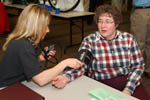Beyond the Challenge:
Accomplishments and Contributions
A positive economic force
The economic impact of UW-Stout on Dunn County and the surrounding region was the focus of a study conducted by NorthStar Economics Inc., of Madison.
The study found the university's impact to be far-reaching, providing vital growth in the economy while adding to job development in the area.
As an institution, UW-Stout contributes more than $312 million to Dunn County's economy -- and almost $344 million to the State of Wisconsin's economy -- annually. UW-Stout employees spend almost $31 million directly in Dunn County each year, while UW-Stout students spend nearly $61 million annually in Dunn County over and above their tuition, fees, and university supplied room and board. Meanwhile, visitors to UW-Stout annually spend $17 million in Dunn County.
UW-Stout's presence in the state generates more than $18 million in state income and sales tax revenue annually; approximately 47 percent of the university's $38 million state allocation for fiscal year 2002–03. More than 63 percent of the $103 million UW-Stout revenue comes from sources other than state taxes.
In addition, UW-Stout activities are responsible for nearly 6,700 jobs in Dunn County and more than 7,200 jobs statewide.
Outside the definitive revenue and jobs numbers the university supports, the study found that UW-Stout's students are making an impact locally. The university's student body contributes more than 36,000 volunteer hours and $1.7 million worth of time to local community services each year.
The study also determined that UW-Stout has an immeasurable positive cultural and social impact on Dunn County's quality of life.
The purpose of the study was to quantify the monetary contribution UW-Stout makes to the regional economy, primarily Dunn County. The monetary contribution stems from UW-Stout institutional spending as well as employee, student and visitor spending. The components of the study came together to show the total economic contribution resulting from UW-Stout's presence in the region.
The study was confined to the economic contribution of UW-Stout, which comes from institutional expenditures and payroll and student and visitor expenditures. It did not measure the economic contribution of affiliated UW-Stout organizations such as alumni associations and foundations; the economic impact of faculty and staff earnings from private consulting, book and patent royalties; the economic impact of faculty and staff expertise used by state businesses and organizations; and a host of other collateral economic activities.
With this in mind, and as impressive as the economic numbers in the study are for the university, the economic impact reported in the study understates the overall economic impact of UW-Stout.
Minority purchasing recognized
UW-Stout was recognized with a Governor's Special Minority Business Award for making a significant percentage of its purchases from minority-owned businesses.
UW-Stout spent just less than $700,000, or 7.45 percent of its total purchases, on business with minority-owned firms in fiscal year 2003. The firms must be classified "minority" by the Wisconsin Department of Commerce.
UW-Stout has received the Governor's Special Minority Award for fiscal year 2000 (5 percent), 2001 (7.24 percent), 2002 (9.54 percent) and 2003 (7.45 percent).
Firms classified a minority business can be sole proprietorships, partnerships, corporations or joint ventures that are at least 51 percent owned, controlled and actively managed by minority group members.
UW-Stout was among 18 state government agencies honored by the governor for making at least 5 percent of their purchases from minority businesses in fiscal year 2003.
(Figure 1)
Employees offered health opportunities
 The Optimal Health Committee supports healthy lifestyles by providing UW-Stout employees with opportunities to increase their health awareness. Approximately 320 people, the largest crowd of staff and students the committee's annual Optimal Health Fair has ever seen, attended the spring 2004 fair to view health-related exhibits; eat chocolate; try out fitness equipment; and receive massages, hearing tests and blood pressure tests.
The Optimal Health Committee supports healthy lifestyles by providing UW-Stout employees with opportunities to increase their health awareness. Approximately 320 people, the largest crowd of staff and students the committee's annual Optimal Health Fair has ever seen, attended the spring 2004 fair to view health-related exhibits; eat chocolate; try out fitness equipment; and receive massages, hearing tests and blood pressure tests.
Other initiatives sponsored by the committee included:
- CPR training.
- skin cancer, fibromyalgia and smoking cessation presentations.
- informational and recreational activities such as a walleye fishing techniques program and cross-country skiing workshop.
- health-related communications with employees through weekly e-mail articles, a newsletter and a Web site developed by students in the applied psychology master's degree program.
Additional Resources:
- UW-Stout's Economic Contribution to the Region
http://www.uwstout.edu/ur/impact04.pdf - Optimal Health
http://www.uwstout.edu/health/
